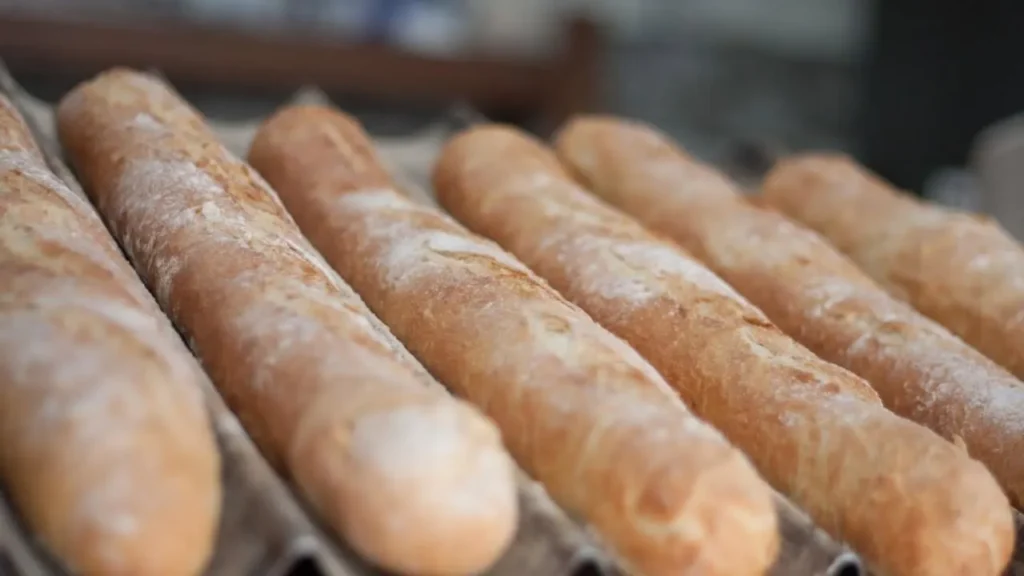
The baguette is as iconic to France as the Eiffel Tower, and like the tower, it has a long and rich history. You may have enjoyed its crunchy “quignon”, but do you know what is a baguette and the story behind it?
Known for its crispy crust and chewy interior, called “Mie” in French, and one of the perfect accompaniments to a variety of dishes. Baguette has humble beginnings dating back to the early 1800s. And today, it is a French cultural symbol recognized by UNESCO and pronounced “bagɛt”.
In this article, you will discover how a baguette is made and what makes it special. Why do the French attach such importance to this simple loaf of bread? How does it differ from regular bread? and the different types of baguettes.
The history of the baguette is truly as timeless as it is delicious.
Related: What is Brioche?
Related: How to keep Baguette Fresh.
What is a Baguette Bread?
Baguette is the classic French bread – a long, narrow loaf with a crisp crust and soft, airy interior. It is made from basic ingredients: flour, yeast, water, and salt.
The word “baguette” means “wand” or “baton” in French, a reference to its distinctive shape.
Typically measuring about 2 feet in length, 2 inches in width, and weighing about 0.5 Lb (250 grams), According to the French Ministry of the Economy. French bakers have turned this simple recipe into an art form.
After fermenting and shaping into a cylindrical shape, the dough is baked at temperatures up to 500°F (260°C), to produce a golden crust with a satisfying crunch. The network of irregular holes created during the fermentation process gives the interior of the baguette a characteristic light and chewy texture.
French baguette should be eaten within a day of baking when the crust is cracked, and the inside is still slightly soft. If you are unfamiliar with this French bread, take a slice and dip it in olive oil, use it to make a sandwich with meat, cheese, or vegetables and your taste buds will thank you. Baguette is also one of the best bread for grilled cheese on our list.
Today, la baguette is still an essential part of French culture and daily life. Visit any French bakery and you will find a fresh batch of baguettes ready to be enjoyed within minutes of coming out of the oven. No surprise that the baguette has endured, representing the pinnacle of the baker’s craft and the joy of simplicity.

The Origins and History of French Baguette
French bread has been mаdе in France since the early 18th century but became popular in Paris in the 1840s. After the Industrial Revolution, mass production of bread became fast and cheap. As a result, baguettes became the first choice of bread for urban workers.
The Parisians fell in love with the portability and crispness of the loaf: perfect for the urban life of Paris, makes it gained popularity in Paris in the early 20th century. Before become a symbol of French identity.
As France rеcovеrеd from the First World War, the government moved to standardize the production of baguеttеs, A law passed in 1919 regulated the weight, ingredients, and price of baguettes to ensure the affordability and quality. This law made the baguette an essential part of everyday life in France.
Today, the baguеttе is recognized around the world as a quintessential symbol of French culture and part of the UNESCO intangible heritage. Every day, millions of French people buy French baguettes to accompany their meals, snacks, or to enjoy on their own. For travelers visiting Paris, no Parisian trip is complete without tasting a baguette still warm from the oven.
How the Baguette Became the Iconic Food of French Culture
Originally, the iconic French bread gained popularity in the early 20th century as a convenient and inexpensive source of daily bread for Parisians. Its long shape made it easy to carry from bakery to home, and its crisp crust and soft interior made it ideal for a variety of French dishes.
Today, the average French person eats around a baguette a day! Whether for breakfast, lunch or dinner. The baguette is an integral part of the daily diet and food culture in France. No cheese plate or French meal is complete without a fresh baguette served alongside it.
In 1993, a French law stipulated that baguettes could only be made from four basic ingredients (flour, yeast, water, and salt). This law was designed to protect the purity of the baguette. The shape, size, and ingredients of the baguette are strictly regulated to guarantee the product’s authenticity.
Though simple in its ingredients, la baguette is an art form when made by a skilled baker. A crispy golden crust, an airy and chewy interior, perfect length and weight – all these factors determine a high-quality French bread. It’s no surprise that the baguette has become a culinary icon and an enduring symbol of French culinary traditions.
Types of Baguettes
France is known around the world for its delicious bread, and the baguette is undoubtedly the most famous. The long, crusty loaf is a staple of any French meal. However, there are many varieties of traditional French bread besides the classic baguette that you should know about:
Ficelle

A Ficelle is a thin, crispy baguette. Although commonly thought of as Italian Bread, Ficelle has been made in France for years. This bread is ideal for dipping in olive oil or soft cheese. It’s made from the same bread ingredients as baguettes but is stretched into long, thin slices before baking.
The Half-Baguette

As its name suggests, a demi baguette is half the length of a traditional baguette with the same shape, flavor, and made from the same dough. Perfect for sandwiches and snacks.
The “Flûte”

Larger than a baguette and weighing up to 14 ounces, this French bread is distinctive and perfect for pairing with cheese or any other food.
The Classic baguette

In terms of ingredients, a classic baguette does not differ much from a traditional baguette, the only difference being the leavening agent used in the dough. the traditional baguette is made with levain, a traditional French sourdough starter, but the classic baguette is made with baker’s yeast. the dough of this baguette is placed in a baguette pan during the baking process, which gives it a more regular and uniform appearance. You can find this type of baguette most often in African countries.
Batard Bread “Bâtard”

Batard bread is also an exception, but in a different way than baguettes, as it is generally wider and heavier than other types of baguettes.
Related: Types of French Bread.
Ingredients to Make Baguette Bread

To make an authentic baguettes, you only need a few simple ingredients:
- Flour: The most important ingredient, which has a high gluten content that gives baguettes their characteristic chewy texture. All-purpose flour can work in a pinch, but bread flour is the best choice.
- Levain: A French sourdough starter made with bread flour, water, and honey or other sweet stuff.
- Salt: Fine, coarse, or kosher salt adds flavor to balance the yeast. Just 1-2 teaspoons is enough for most baguette recipes.
- Water: Water hydrates the dough. The exact amount depends on the flour you use and the humidity, so you may need to adjust. The dough should be slightly tacky, but not sticky.




